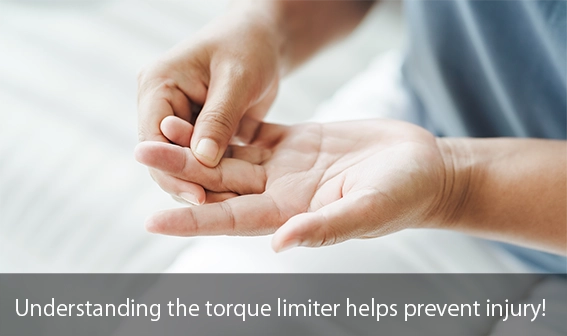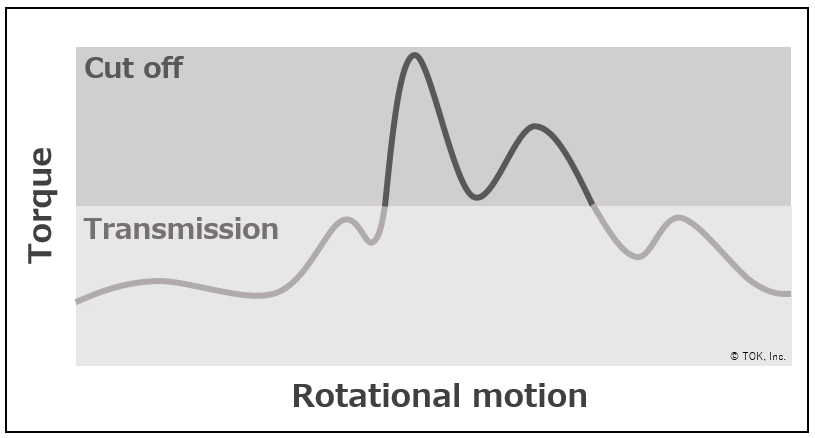
Torque limiters have a mechanism that automatically cuts off power transmission when the set torque is exceeded to prevent overloading due to high torque. Once you have a better understanding of the torque limiter mechanism, you can consider suitable uses. For example, if you want to prevent injury due to pinching of fingers, you may need a huge number of mechanisms such as sensors and controls. However, if you understand the torque limiter mechanism, you can solve the problem using only the torque limiter.
In this article, we explain in detail the motion and the role, the mechanism of the motion, and the situations in which it is suitable for use of torque limiters.
Contents
The motion and the role of torque limiters

A torque limiter is a component that automatically idles the output shaft against the input shaft to shut off torque transmission when the torque exceeds a set value. As shown in the gif video above, by equipping an electric screwdriver with a torque limiter, it is possible to tighten screws without placing a burden on the glasses. Without a torque limiter, the motor continues to transmit rotation to the screw even after the screw is tightened, resulting in excessive load and damage. However, with a torque limiter, the force from screw tightening is transmitted to the housing, interlocking with the sleeve inside the housing is cut off, and the motor does not continue to transmit force to the screw after screw tightening and the screw can be installed. The mechanism of the torque limiter motion is explained in detail in the next chapter.
The mechanism of the motion of torque limiters

As shown in the figure above, there are two areas of torque transmission, the blocking area and the transmitting area, with the set torque as the boundary. The torque limiter can transmit power no matter how the torque value fluctuates as long as the set torque is not exceeded. On the other hand, if the set torque is exceeded, the torque limiter will continue to cut off power as long as the torque value does not drop below the set torque.
If the torque limiter is below the set torque and in the transmission area, the electric screwdriver mentioned in the last chapter will continue to tighten the screw. The torque limiter and shaft work together to transmit power to the screw as the housing and the sleeve inside the housing rotate together. The moment the torque limiter exceeds the set torque and enters the cutoff area, the electric screwdriver stops tightening the screw. The interlocking of the torque limiter housing and sleeve is cut off, and only the sleeve rotates, so that power is not transmitted to the screw and the torque limiter is still functioning. The torque limiter allows the user to adjust the tightening force of the screw depending on the set torque, thus preventing product failure.
Three situations where the use of a torque limiter is suitable

Situation 1: Positioning
Torque limiters are effective for positioning. For example, when a torque limiter is installed on an automatic curtain, it transmits power to open and close the curtain in the transmission area, but the moment the curtain is fully opened or fully closed, it enters the cut off area because the torque exceeds the set torque and cuts off the power. This prevents the curtain from moving too much beyond the set position.
Situation 2: Safety measures
Torque limiters are also useful in preventing injury. When fingers or foreign materials are caught in the shutter or conveyor belt, the load is greater than the set torque, so power is not transmitted, preventing injury or machine breakdown. When an odd thing occurs on the machines, the torque limiter can prevent accidents from occurring.
Situation 3: Slow operation
Torque limiters are also suitable for situations where you want to intentionally have a slow operation for a high class product. For example, instead of turning the volume control knob of audio equipment vigorously, you can intentionally slip the knob to make it rotate with a sense of resistance, giving it a luxurious motion and allowing the volume to be minor adjusted.
Summary of torque limiter mechanism | Explain the transmission and the cut off of power
It is difficult to understand the operation of a torque limiter from the outside, but by looking at the actual movement and graphs, you may be able to imagine the transmission of power.
For more information on how to use the torque limiter, please see this page.
If you would like to obtain more detailed information, please contact us using this contact form.
If the form does not appear after a few moments, please contact us from here.







